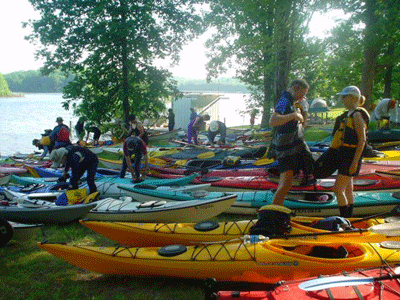Tales of a 21st Century Gypsy
May 16, 2004 Subcultures - Sea Kayaking.
Some people go through life working each day, returning home, talking to their spouse or their children, watching television, working on their house, taking care of errands, reading the newspaper, and not too much else. Children take lots of time, work takes lots of time, work and children and spouse seem to combine to become a major drain of energy.
 |
| Photo by Robert (Woody) Woodard. |
What results is a subculture, a community organized around this activity. In the past few months I’ve begun to realize how many such subcultures there are all around us. It’s a curious feeling, as if I’d been living in a two dimensional world, and suddenly realized that the world around me actually has dozens of dimensions all co-existing without even seeing each other.
The vanagon community is one such subculture, of course, a new one to me since I went on the road. I’ve seen many others, though. I spent this weekend in the sea kayaking culture, where I traveled regularly before I moved to New Jersey. I began sea kayaking eight years ago because I wanted to look at birds from the water instead of the land. I immediately fell in with a group of people paddling in the Chesapeake Bay area, and just as quickly realized that kayaking was far more fun on its own than as a way to birdwatch. In May I returned to that group to help out at “Sea Kayaking 101,” an annual event on the shores of Lake Anna, near Richmond, Virginia. Lake Anna is the discharge area for a nuclear power plant, and its waters are heated as a result. In mid-spring it’s too cold to teach novices how to do rescues and rolls without cold water gear that they havnen’t bought yet, but the warm water of Lake Anna makes it all possible. A couple of long-time Chesapeake Paddlers Association members own property there, and allow the club to use it for this training course.
I think the most splendid thing about kayak events is the boats. They line up on the shore of the lake in rows, long sleek boats in yellow and red and royal blue and orange and turquoise, the occasional long wood one like mine, a few short squirty whitewater boats on the edge. Before classes begin, we're all on the shore fussing with our boats, getting on our gear, hauling them into the water. After classes have ended, our edge of the lake teems with boats. People paddling, practicing lessons, learning to roll, playing games of tag and chase, chatting, showing off, trying each other’s boats. A few people, like me, are in the water instead of on it, grabbing boats and trying to flip them, holding the sterns and making them tow us around the lake, floating on noodles and boogie boards, swimming purposefully across the lake. It’s like a crowd at a party, everyone busy about their conversations and activities and games in the water.
SK 101 is officially a training event, but it’s also a social event, a way to meet new paddling partners, and new life partners – a number of couples met there, and one is now married and expecting a child. I know the old-timers who were part of the club before I left, but I wander around talking to new folks. Some have just started kayaking, and they’re exploring the subculture they’ve just discovered. They ask all the beginner questions, like me in the vanagon world - where should they paddle, what difference does boat length make, how does my narrow wooden Greenland paddle differ from their wide-bladed carbon fiber one, do they have to learn to roll, should they take a course in paddling technique, do they really need a wetsuit? Others – mainly the instructors – discuss the advanced certifications they seek, the dangerous trips they took, the vacations paddling along the Maine coast or on Hudson Bay that they are planning. They compare high-tech gear, boast of the new ways they have learned to roll their boats, debate the safest way to handle high seas or difficult winds, analyze how to navigate with a compass in fog or ferry across a river in a swift current.
When I was a newbie I loved getting into this world, but right now I feel a bit outside of it. I suppose we – or I, at least – move from one subculture to another, and this one isn’t where I live right now. It’s odd feeling outside of a club that I ran for several years, but it’s okay, too. Moving on is a nice thing right now.
And before I left someone came up to me and said he had a vanagon too. It felt like meeting a fellow-countryman when traveling abroad! So the sea kayak culture and the vanagon culture overlapped for a half hour, as we compared the arrangement of our vans and the work we’d had done on them, and then helped each other load our handmade wooden kayaks on top of our pop-tops.
Continue to the next entry.
Return home.
Unless otherwise indicated all text and photos on this site ©Joy E. Hecht.